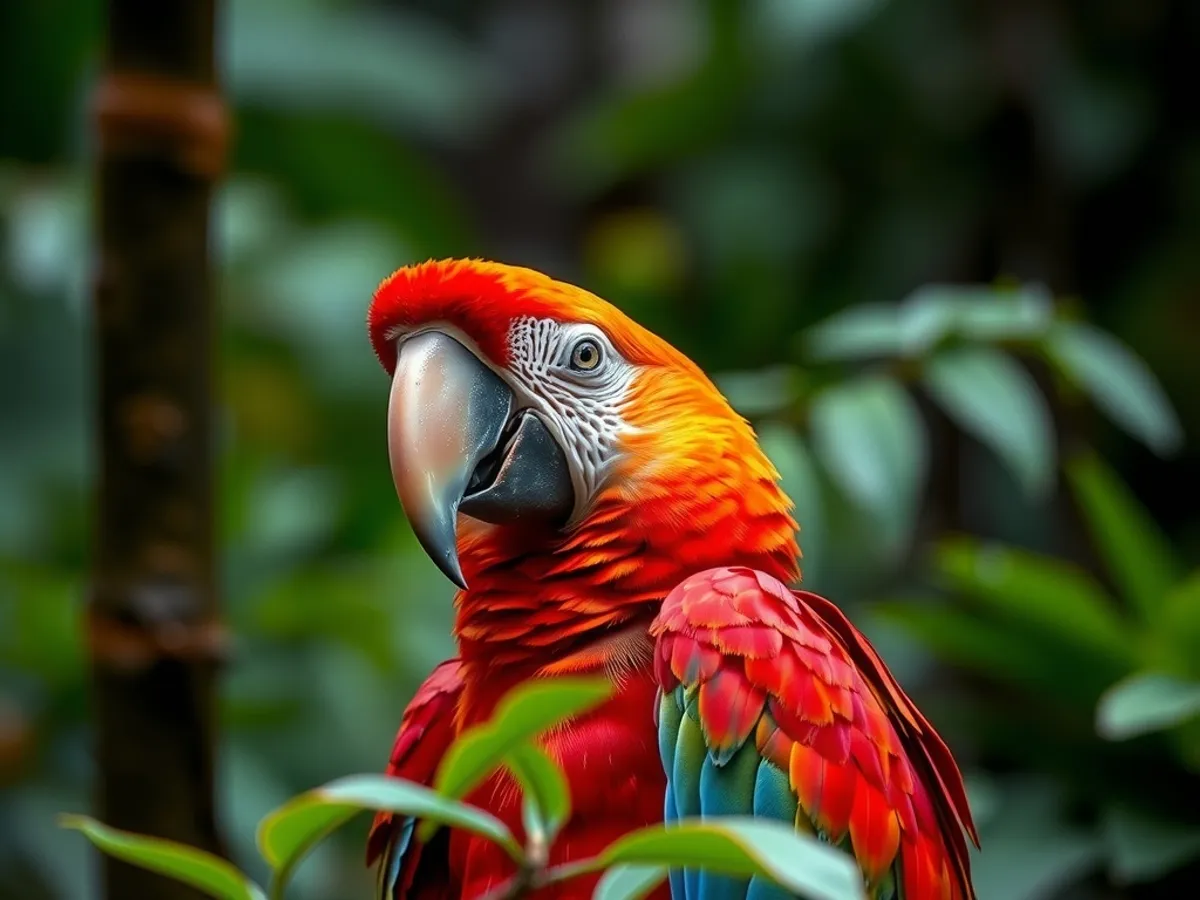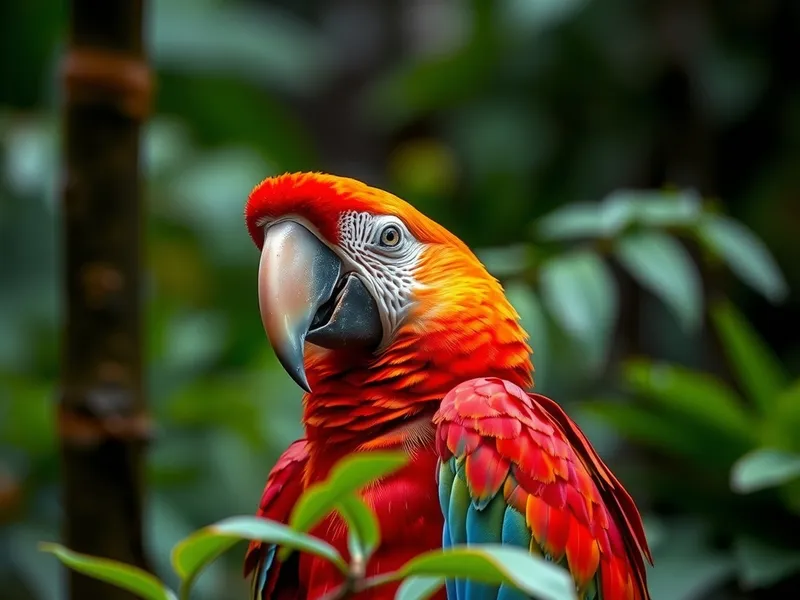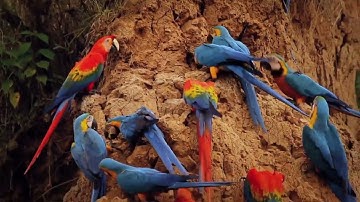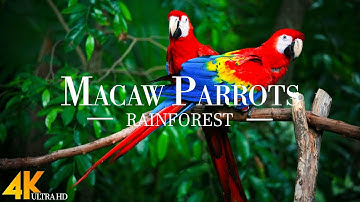
Scarlet Macaw
Ara macao

Meet the Scarlet Macaw
The Scarlet Macaw is a large, brilliantly colored parrot native to the humid evergreen forests of Central and South America. Recognized for its striking red, yellow, and blue plumage, this bird is both an iconic symbol of the neotropics and a vital seed disperser in its ecosystem. Scarlet Macaws are highly social and intelligent, often seen flying in pairs or small flocks and communicating with loud, distinctive calls. Their powerful beaks are adept at cracking hard nuts and seeds, and they are known for their long, graceful tails and strong, agile flight. Due to habitat loss and illegal pet trade, their populations have declined in some areas, but they remain widespread in protected regions.
Classification
Bird
Habitat
Tropical rainforest
Diet
Herbivore
Lifespan
40-50 years (wild), up to 75 years (captivity)
Conservation
Least Concern
Weight
900–1,200 g
📖Fascinating Facts
Brilliant Plumage
The Scarlet Macaw's vivid red, yellow, and blue feathers help it blend into the colorful rainforest canopy and attract mates.
Seed Disperser
By feeding on a wide variety of fruits and nuts, Scarlet Macaws play a crucial role in dispersing seeds and maintaining forest diversity.
Lifelong Bonds
Scarlet Macaws often form monogamous pairs that stay together for life, sharing feeding and parenting duties.
📋Detailed Description
The Scarlet Macaw (Ara macao) is a large, long-tailed Neotropical parrot, measuring 81–96 cm (32–38 in) in length and weighing 900–1,200 g (2–2.6 lbs). Its plumage is predominantly bright red, with striking yellow and blue on the wings and tail, and bare white facial skin lined with small red feather tracks. The robust, hooked beak is pale horn-colored above and black below, perfectly adapted for cracking open hard nuts and seeds. Scarlet Macaws exhibit strong, direct flight powered by long, pointed wings, and are capable of covering large distances in search of food. Highly social, they form monogamous pairs and are often observed in small family groups or larger flocks, especially at communal clay licks. Their vocalizations are loud, raucous squawks and screams, used for communication across dense forest canopies. The species is diurnal, spending much of the day foraging, preening, and engaging in social interactions. Scarlet Macaws play a crucial ecological role as seed dispersers, influencing forest composition and regeneration. Their intelligence is notable, with advanced problem-solving abilities and complex social behaviors observed both in the wild and captivity.
💡 Did you know?
Scarlet Macaws can mimic human speech and sounds, making them popular (but challenging) pets.
🔬Research & Sources
Wikipedia Summary
The scarlet macaw also called the red-and-yellow macaw, red-and-blue macaw or red-breasted macaw, is a large yellow, red and blue Neotropical parrot native to humid evergreen forests of the Americas. Its range extends from southeastern Mexico to Peru, Ecuador, Colombia, Bolivia, Venezuela, Honduras, and Brazil in lowlands of 500 m (1,600 ft) up to 1,000 m (3,300 ft), the Caribbean island of Trinidad, as well as the Pacific island of Coiba. Formerly, the northern extent of its range included southern Tamaulipas. In some areas, it has suffered local extinction because of habitat destruction, or capture for the parrot trade, but in other areas, it remains fairly common. It is the national bird of Honduras. Like its relative the blue-and-yellow macaw, the scarlet macaw is a popular bird in aviculture as a result of its striking plumage. It is the third most common macaw species in captivity after the Blue and Gold and Greenwing Macaw respectively. In recent years it has become much rarer in captivity and much more expensive due to stricter laws, its price being higher than even red-and-green macaw.
Last Modified: 5/22/2025
🎭Behavior & Social Structure
Scarlet Macaws are primarily arboreal, spending most of their lives in the forest canopy. They are generalist herbivores, feeding on a wide variety of fruits, nuts, seeds, berries, and occasionally flowers and leaves. They are known to visit mineral-rich clay licks, which may help neutralize dietary toxins from unripe or toxic seeds. Foraging is often a social activity, with pairs or small groups moving together through the forest. Macaws maintain strong pair bonds, engaging in mutual preening and synchronized flight. Social hierarchies are evident in larger flocks, with dominant individuals gaining preferred access to resources. Their daily routine includes early morning and late afternoon foraging flights, midday resting and preening, and communal roosting at night. Juveniles remain with parents for extended periods, learning essential survival skills through observation and imitation.
👶Reproduction & Life Cycle
Scarlet Macaws are seasonally monogamous, forming lifelong pair bonds. Breeding typically occurs during the dry season, varying regionally but often from November to April. Pairs select large tree cavities, often in emergent rainforest trees, for nesting. The female lays 1–4 white eggs, which she incubates for about 24–28 days while the male provides food. After hatching, both parents feed the chicks, which are altricial (helpless and featherless at birth). Fledging occurs at 90–100 days, but young may remain dependent on parents for several months. Reproductive success is limited by the availability of suitable nest sites and predation by mammals and birds of prey. In the wild, Scarlet Macaws may not breed every year, and clutch sizes are often small, contributing to slow population recovery.
🛡️Adaptations & Survival
Scarlet Macaws possess several key adaptations for survival in tropical forests. Their powerful beaks can exert forces exceeding 300 psi, enabling them to crack open the hardest nuts and seeds, including those toxic or inaccessible to other species. Zygodactyl feet (two toes forward, two back) provide a strong grip for climbing and manipulating food. Their vivid coloration offers camouflage among the bright fruits and flowers of the rainforest canopy, while also serving as a social signal. The species' intelligence supports complex problem-solving and social learning, crucial for navigating dynamic forest environments. Vocalizations are adapted for long-distance communication in dense forests. Their digestive system is tolerant of certain plant toxins, aided by clay consumption at mineral licks.
📚Research Sources
🎨Cultural Significance
The Scarlet Macaw holds deep cultural significance throughout its range. It is the national bird of Honduras and features prominently in indigenous mythology, art, and folklore, often symbolizing beauty, power, and the connection between earth and sky. Ancient Maya and Aztec civilizations revered the macaw, using its feathers in ceremonial headdresses and ritual objects. Today, the bird is a flagship species for ecotourism and rainforest conservation, and its image is widely used in branding, education, and conservation campaigns. In some regions, traditional uses of feathers and live birds persist, though these are increasingly regulated.
🔬Recent Research & Discoveries
Recent research has focused on the Scarlet Macaw's role as a keystone seed disperser, with studies showing their importance in maintaining forest diversity. Genetic studies have revealed two subspecies (A. m. macao and A. m. cyanopterus), with subtle differences in size and wing coloration. Conservation genetics is being used to guide reintroduction and management programs. Ongoing telemetry studies track movement patterns, habitat use, and responses to habitat fragmentation. Research on vocal learning and social cognition in wild and captive populations continues to shed light on the evolution of intelligence in parrots. Community-based conservation initiatives, particularly in Costa Rica and Peru, have demonstrated success in increasing local macaw populations.
🎥Wildlife Videos

Scarlet Macaw - 5 Minute Documentary
Embark on a breathtaking five-minute journey into the vibrant world of the Scarlet Macaw with a mesmerizing documentary that ...
Five Minute Documentaries

Documentary of Macaws parrots / Natural wild life( jungle life of Large parrots).
Documentary of Macaws parrots/Macaws parrots wild life ( Nature Documentary) #parrot #viral .@TheParrotsTv1 Note : This ...
TheParrotsTv

Meet Scarlet Macaw Geoffrey | Parrot Confidential | Nature on PBS
Parrot Confidential premieres Wednesday, Nov. 13, at 8/7c on Nature on PBS. For more visit: http://www.pbs.org/wnet/nature/ ...
Nature on PBS

Macaw Parrots 4K - Relaxing Music With Colorful Birds | Nature Sounds of Jungle, Rainforest
Enjoy the peaceful and colorful nature views in beautiful 4K UHD. Relax with beautiful and colorful Macaws Parrots like the ...
Relaxing Nature Music

Survival of the Scarlet Macaw | How to save Mexico's Endangered Parrot
Scarlet macaws have disappeared from Mexico in huge numbers. Prized as pets thanks to their beautiful plumage, they've ...
Terra Mater

Scarlet Macaws Feed on Clay Licks (Narrated by David Tennant) - Earthflight - BBC
#bbc.
BBC
🌍Habitat Information
The Scarlet Macaw typically inhabits Tropical rainforest environments. Scarlet Macaws have adapted to their environments with specialized features and behaviors.
Primary Habitat:
Tropical rainforest
More detailed habitat information will be available soon.
🛡️Conservation Status
The Scarlet Macaw is currently classified as Least Concern. Conservation efforts are crucial for preserving this species for future generations.
Common Threats:
- 🏠Habitat loss and fragmentation
- 🌡️Climate change impacts
- 🎯Hunting and poaching
- 🏭Human-wildlife conflict
⚠️Threats & Conservation Challenges
Major threats to Scarlet Macaws include habitat loss from deforestation, fragmentation of nesting and foraging habitats, and illegal capture for the pet trade. Nest poaching remains a significant problem, particularly in regions with weak law enforcement. While the species is classified as Least Concern by the IUCN, local extinctions have occurred in parts of Mexico, Central America, and the Pacific coast. Population trends are stable in protected areas but declining elsewhere. Conservation challenges include ensuring the protection of large tracts of intact forest, securing nest sites, and enforcing anti-poaching regulations. Climate change poses an emerging threat by altering forest structure and food availability.
🔬Scientific Classification
Scientific Name
Ara macao
Classification Hierarchy
🔍 About Taxonomic Classification
Taxonomic classification is a hierarchical system used by scientists to classify and organize living organisms based on shared characteristics and evolutionary relationships.
The system moves from broad categories (Kingdom) to increasingly specific ones, with each animal's scientific name typically consisting of its Genus and species.
📝Community Notes
Share your observations and insights about the Scarlet Macaw with our community of wildlife enthusiasts.
Join Our Community
Sign in to share your observations and connect with fellow wildlife enthusiasts.
Sign In to ContributeNo community notes yet
Be the first to share your observations about the Scarlet Macaw!
Explore Scarlet Macaw
Select a tab above to learn more about this amazing animal.
📸Photo Gallery
No photos available for this animal yet.
🌟Discover More Wildlife
Continue your journey of discovery with more fascinating animals from our database
